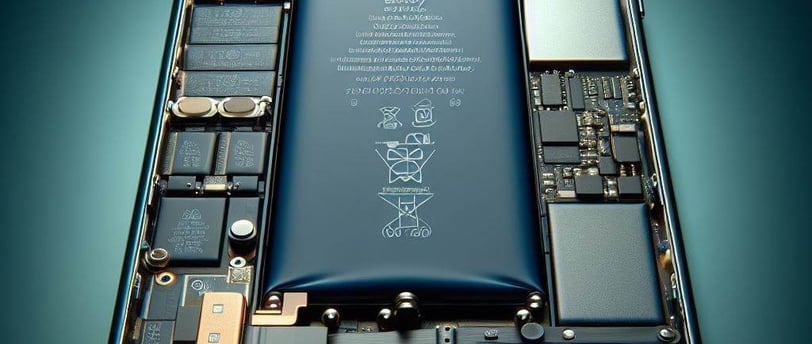How to Know When Your iPhone Battery Needs to Be Replaced?
NEWS
9/12/20244 min read


Learn to identify the signs that indicate when your iPhone battery needs replacing and what to do if it's time.
In August 2023, reports emerged that the batteries of the iPhone 14 series were depleting and losing capacity faster than expected, with users noting a 10% drop in battery life after just one year.
Users wouldn’t be aware of their battery’s diminishing capacity if Apple didn’t provide them with this information. Apple was forced to do this a few years ago after the "Batterygate" scandal, when it was discovered that the company was slowing down iPhones with degraded batteries. Apple claimed this was to prevent iPhones from shutting down unexpectedly. Since iOS 11.3 launched in early 2018, you can go to Settings > Battery and tap Battery Health to check your battery’s status.
Recently, Apple has made changes to iOS to extend battery life, including the Optimized Battery Charging feature, which prevents the iPhone from staying fully charged for too long. Optimized Battery Charging has been the default setting since the release of iOS 13 in 2019.
But why does the iPhone battery lose its ability to hold a charge over time? When should you replace your iPhone battery? You may also want to know how to tell if the battery in a used iPhone has been replaced.
Why Does the iPhone Battery Deteriorate Over Time?
One undeniable fact is that over time, an iPhone battery will eventually lose its ability to hold a charge, just like the battery in any other phone.
This is due to the chemical reactions inside the lithium-ion battery, which cause it to degrade over time. So, if your iPhone’s battery no longer lasts as long as it used to, you’re not alone. All batteries become less efficient with age, and unfortunately, your iPhone’s battery is no exception.
As the battery ages, it may require more frequent charging, hold less power, or even start causing unexpected shutdowns. You may have already noticed these changes, but if you want to see proof, it’s easy to check your battery’s condition.
How to Check iPhone Battery Health
In early 2018, Apple released an iOS software update with new features that the company said would "give users more visibility into their iPhone's battery health, so they can see for themselves if the condition is affecting performance." It’s quite easy to access this information:
Open Settings.
Tap Battery.
Tap Battery Health & Charging (in older iOS versions, it may simply display as Battery Health).
Note the percentage next to Maximum Capacity.
Additionally, look at the message under Peak Performance Capability. This message may include details about whether your iPhone is experiencing any battery-related issues.
Here, you can see the maximum capacity, which for a one-year-old iPhone 14 in Macworld's test was 95%.
If you’re wondering how bad your iPhone's capacity is, it’s typically considered poor when it's under 80%. However, it’s understandable for users to expect a capacity above 90% if their iPhone is less than a year old.
How to Know When It's Time to Replace Your iPhone Battery?
When your iPhone battery has surpassed 500 full charge cycles, it’s likely time for a replacement. Unfortunately, iOS does not show how many charge cycles your battery has gone through, but it tries to prevent too many full charges with the Optimized Battery Charging feature mentioned earlier.
However, when your iPhone’s Battery Health drops to 80%, it’s time to consider replacing the battery. In fact, Apple will display a message: "Your battery's health has significantly degraded. An Apple Authorized Service Provider can replace the battery to restore full performance and capacity."
If your iPhone’s battery—or a used iPhone you’re considering purchasing—has dropped to 80% or below, it’s advisable to get a new battery.
There are also several other signs that your iPhone may need a new battery: the backlight is dimmer than usual; the speaker volume is lower; the screen stutters when scrolling; frame rates drop in some gaming apps, and apps take longer to launch.
What Happens If You Don’t Replace the iPhone Battery?
If you see a message indicating your battery health has decreased, you can continue using your phone, but its charge capacity may reduce, and you might encounter some minor stability issues when the battery is low.
If your battery is no longer performing well, you might also notice that Performance Management is being applied to prevent sudden shutdowns. You may see a note in the Peak Performance Capability section of Battery Health, stating, "This iPhone has experienced an unexpected shutdown because the battery was unable to deliver peak power." To address this, Performance Management is applied.
Performance Management is a feature that applies only to older iPhone models, before iPhone 11. If you’re playing a graphics-intensive game while your battery is below 20%, this setting might kick in.
How to Know If an iPhone Battery Has Been Replaced
There are a few ways to determine whether the battery in a used iPhone you purchase has been replaced, and more importantly, to check if it’s an Apple component rather than a potentially dangerous third-party battery.
To find battery details, follow these steps:
Open Settings.
Go to General.
Tap About.
Scroll down and look for the section titled "Parts and Service History." Here, you may find details about the battery if it has been replaced.
You shouldn’t worry if it’s an Apple Genuine Part, but an unverified third-party component may cause issues with your iPhone.
How to Maximize iPhone Battery Life
If you want to make sure your battery lasts as long as possible before you have to replace it, try the following tips:
Turn off Location Services.
Disable Background App Refresh.
Make sure Auto-Brightness is enabled.
Use Airplane Mode when you don’t need an internet connection.
